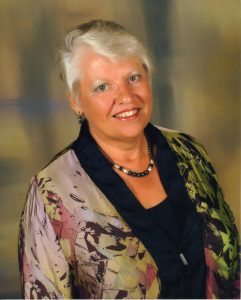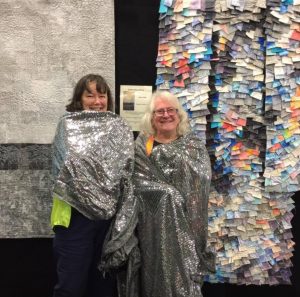We’ve all known the challenge of awakening others to the artistic possibility—to say nothing of the sheer unmitigated beauty—of the art quilt. Some of us are reps struggling to find ways for people in our regions in isolated areas to share ideas and the society of other creative people. Consider the region of Oceania: the sum of the whole of vast Australia, New Zealand with its two large islands, Brunei, and Hong Kong.
Oceania’s roughly 137 members are spread over more than three million square miles. Imagine territory as diverse as the lush green meadows of New Zealand, the unforgiving Australian outback, vibrant cities from Auckland, NZ to Sydney, AU, the long, winding coastlines that characterize “Oceania”. This is without counting the areas of tiny Brunei (one British SAQA member) plus Singapore and bustling Hong Kong, which both claim one ex-patriot Australian art quilter. Now think of those 137 art quilters scattered over all that territory – an average of one for roughly every 26,000 miles. That’s comparable to a country the size of Ireland with one art quilter, or one in the Canadian province of New Brunswick. Imagine just one art quilter in the state of West Virginia.

Yet Rasa Mauragis, Oceania rep, is finding ways to unite SAQA members down under. Although Oceania is an established region, it continues to evolve as it finds ways to bring its members ever closer together. “We definitely struggle with what we call ‘the tyranny of distance’,” she says. “We’re always working on ways to bring our members closer.”
Connecting in person and online
The region is gelling, despite the fact that members don’t tend to be clustered together, even in large cities. “We have meetups at quilt shows,” says Mauragis, “but those tend not to be large gatherings, often just a handful of people, because we tend to live so far apart.” The Australian Quilt Convention is one of the best opportunities for Oceania members to meet up. Regional get-togethers have been organized by previous Oceania reps, and their efforts are bearing fruit. Last year, former rep Lisa Walton organized a dinner at the conference that was attended by more than 30 SAQA members from Oceania. “And we encourage members to bring friends,” said Walton. “We also invite any visiting SAQA members, including any international teachers in town for the show.”

Internet access, such an important tool for bringing isolated people together in many parts of the world, is spottier in some of Australia’s farther reaches. “It’s one of our biggest challenges,” notes Mauragis. But she’s proud of the participation in Oceania’s closed Facebook group, “OMG! SAQA’s Oceania Group”. “We have about 75% participation,” she says. The “OMG!” Facebook group is a closed group, requiring approval by an administrator before a Facebook user is able to view the content shared by group members. Starting a closed group rather than a page was a deliberate and carefully considered decision, says Mauragis. Even though Oceania region members feel strongly about educating the public about the art quilt, the security concerns of members and their families came first. So the region uses its private Facebook group as a way to connect and share information about events, encouragement, and inspiration.
Members who don’t use Facebook are kept in the loop via the four annual newsletters produced by SAQA Oceania member Buffy Beggs. Maggie Gilbert provides IT support for the region.
Flexing those artistic muscles across many, many miles
Art challenges issued via the group help members to flex their creative muscle. Recently, expat Australian member Alison Schwabe, now living in Montevideo, Uraguay, challenged Oceania members to make a 25cm. square art quilt using materials they already had in the studio. “We try to tap into our members regardless of where they live,” said Mauragis. Another recent challenge involved including rubbings.
Like SAQA regions everywhere, Oceania has worked hard at correcting the misimpression that SAQA is meant for only highly successful, “all in” professional artists. Mauragis feels that her region is succeeding in letting art quilters know that Oceania is a place for artists of all levels of skill and interest. And career art quilters are appreciative of the exhibit opportunities offered by SAQA. “We still struggle to have our work exhibited alongside other types of art here,” says Mauragis. “We’re beginning to see art quilt or wall quilt categories at the bigger shows, but my own work, for example, is considered ‘mixed media’ by most non-quilt art shows. Fiber art—art quilts—are not yet recognized by the art community here.”
Like artists everywhere, Oceania’s members’ work is as diverse as the vast territory they share. While many Oceania artists reference the land in their work, Mauragis says that many others don’t. “We have such variety,” she added. “We see a lot of people working with abstract themes. Others are drawn to show a sense of time, of history. Others concentrate on themes relating to human relationships. And the approach varies, with some people working in series and others maintaining a recognizable style of one-off works unrelated to each other. It’s all over the map.”
A region giving back
Mauragis is proud of the fact that despite the lack of a philanthropic culture in her part of the world, the Oceania region responded enthusiastically to SAQA’s 2016 annual Benefit Quilt auction. Despite the challenges of distance, internet access, and the newness of the region, Oceania was the single largest contributor, with 25 pieces sent across the Pacific and sold to bidders all over the globe. “This was seen as a great opportunity: a chance to have our work seen in a non-juried, international forum,” says Mauragis.
The region was able to further capitalize on that success by devising a “Blog Hop” after the Benefit Auction quilts had been created. “About 17 or 18 quilters captured images of their quilts, along with process notes and images,” says Mauragis. “They posted these to their blogs, and every other day, we posted links to one artist’s blog on our Oceania blog. Geographical distance just doesn’t make it possible for us to have a physical tour of several studios in a day, but we were able to give our members a look at how several of us create.”
With all the success of this relatively young region, Mauragis still is concerned with the roughly 10% of Australian Oceania members whom she suspects have no or sporadic internet access. She knows that there may be more internet-challenged members in other parts of the region. Problem-solving continues, and so do plans for more opportunities for art quilters in Oceania. Watch for their 2019 exhibit, still in the planning stages. What seems very likely though, given the energy and spirit of the diverse Oceania region, is that it will be a treat for the eye and the mind.
Written by Carolyn Higgins – Interview with Rasa Mauragis (February 24th, 2017)
